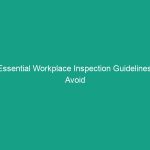Introduction
The importance of health, safety, and environmental (HSE) management in the workplace cannot be overstated. Every organization, regardless of its size or industry, must prioritize the well-being of its employees. A robust health and Safety program not only protects workers but also enhances productivity and fosters a positive workplace culture. This article aims to provide essential guidelines for effective health and Safety program evaluation, a critical component in ensuring that Safety Measures are working as intended and continuously improving. Evaluating a health and safety program allows organizations to identify gaps, assess compliance with Regulations, and implement Best Practices that promote a safe working Environment.
Regulatory Frameworks for Health and Safety
Understanding the regulatory frameworks that govern Workplace Health and safety is crucial for any organization. These regulations vary by country and industry but generally provide a baseline for safety Standards that must be adhered to. Compliance with these regulations is not just a legal obligation; it reflects a company’s commitment to protecting its workforce.
Key Regulatory Bodies
In the United States, the Occupational Safety and Health Administration (OSHA) is the primary regulatory body overseeing Workplace Safety. osha sets forth regulations that employers must follow to ensure a safe working environment. Similarly, in the European Union, the European Agency for Safety and Health at Work (EU-OSHA) plays a pivotal role in promoting safe and healthy workplaces. Understanding these regulatory frameworks is essential for effective health and safety program evaluation.
Compliance and Best Practices
Organizations must not only comply with legal requirements but also strive to exceed them by adopting industry best practices. These practices may include regular risk assessments, employee Training, and the implementation of safety management systems. A thorough health and safety program evaluation should assess compliance with these regulations and the effectiveness of best practices in place.
Best Practices for Health and Safety Program Evaluation
Implementing best practices in health and safety program evaluation can significantly enhance the effectiveness of an organization’s Safety Measures. Below are some key best practices that organizations should consider.
Regular Audits and Inspections
Conducting regular audits and inspections is essential for identifying potential Hazards and ensuring compliance with safety standards. These audits should be planned and systematic, covering all aspects of the health and safety program. By scheduling regular evaluations, organizations can proactively address issues before they escalate into serious incidents.
Employee Involvement
Engaging employees in the evaluation process is a best practice that fosters a culture of safety. Employees are often the first to notice unsafe conditions or practices, so their feedback is invaluable. Organizations can implement surveys or focus groups to gather employee insights, which can then inform health and safety program evaluation.
Data-Driven Decisions
Utilizing data to inform decisions is a critical aspect of an effective health and safety program evaluation. Organizations should collect and analyze data related to workplace incidents, near misses, and safety violations. This data can illuminate trends and help identify areas needing improvement, ensuring that evaluations are grounded in factual information rather than assumptions.
Case Studies: Successful Health and Safety Program Evaluations
Learning from real-world examples can provide valuable insights into effective health and safety program evaluation. Below are a couple of case studies that illustrate successful practices.
Case Study 1: Manufacturing Industry
A manufacturing company faced high rates of workplace injuries, prompting a comprehensive evaluation of its health and safety program. The company implemented a series of audits and engaged employees through safety committees. By analyzing incident data, they identified key risk areas and tailored their training programs accordingly. Over the course of two years, the company saw a 40% reduction in workplace injuries, highlighting the importance of a structured evaluation process.
Case Study 2: Construction Sector
In the construction sector, a contractor recognized the need for an effective health and safety program evaluation after experiencing compliance issues. They adopted best practices, including regular safety audits and employee involvement in safety planning. By leveraging technology to collect and analyze safety data, the contractor was able to enhance their evaluation process and improve safety outcomes, resulting in zero OSHA violations over three consecutive years.
Challenges in Health and Safety Program Evaluation
While evaluating health and safety programs is crucial, organizations often face challenges that can hinder the process. Understanding these challenges is the first step in overcoming them.
Resistance to Change
One of the most significant challenges is resistance to change. Employees and management may be accustomed to existing safety practices and may resist new evaluations or changes. To combat this, it is essential to communicate the Benefits of evaluation and involve employees in the process. Change management strategies should be implemented to ease the transition.
Lack of Resources
Another challenge is the lack of resources, including time, budget, and personnel. Health and safety program evaluation can be resource-intensive, requiring commitment from various levels of the organization. To address this, organizations should prioritize health and safety within their operational budgets and allocate resources accordingly.
Inconsistent Data Reporting
Inconsistent data reporting can also pose a challenge in evaluating health and safety programs. Organizations must establish clear protocols for data collection and reporting to ensure that information is accurate and reliable. Training employees on data entry and reporting processes can help improve consistency and quality.
Future Trends in Health and Safety Program Evaluation
As the workplace continues to evolve, so too will the approaches to health and safety program evaluation. Being aware of future trends can help organizations stay ahead of the curve.
Technology Integration
Advancements in technology are transforming how organizations evaluate health and safety programs. Tools such as artificial intelligence and machine learning can analyze large datasets to identify trends and predict potential safety issues. Additionally, mobile applications are increasingly used for incident reporting and safety audits, making it easier for organizations to collect data and respond promptly.
Focus on Mental Health
Another emerging trend is the growing emphasis on mental health within the workplace. Organizations are beginning to recognize that mental well-being is as important as physical safety. Evaluating health and safety programs will increasingly involve assessments of workplace culture, stressors, and employee mental health resources.
Holistic Safety Approaches
Finally, a holistic approach to health and safety program evaluation is gaining traction. This involves looking beyond traditional safety metrics and considering the overall health and well-being of employees. Organizations may adopt comprehensive wellness programs that address physical, mental, and emotional health, integrating these elements into their safety evaluations.
Conclusion
In conclusion, effective health and safety program evaluation is essential for organizations striving to protect their employees and foster a culture of safety. By understanding regulatory frameworks, implementing best practices, learning from case studies, addressing challenges, and anticipating future trends, organizations can significantly enhance their health and safety programs. Remember, a successful evaluation is not a one-time event but an ongoing process that requires commitment, engagement, and adaptability. As you move forward, prioritize the health and safety of your workforce, and make evaluation a cornerstone of your organizational strategy. Together, we can create safer workplaces for all.


